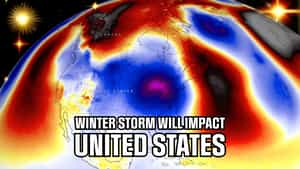Dust storm from the Sahara will cover Europe: what to expect in the coming days

Friends, hold on tight – a real dust storm is heading our way straight from the Sahara! If you have already noticed a slight yellowish tint on the horizon or felt that the air has become somehow “heavy”, then this is not just the vagaries of the weather. A large cloud of Sahara dust, like an uninvited guest, is moving across the Mediterranean Sea, covering southern and central Europe, and at the same time looking in on us, in Ukraine. The peak of this dust invasion is expected on April 16, so let’s figure out what kind of beast it is and how to live with it in the coming days.
Dust is heading for Europe: where will it be thickest?
According to European meteorologists, in particular the Spanish agency AEMET, the dust cloud has already crossed the Mediterranean Sea and is confidently marching across southern Italy, heading to the central and southeastern regions of Europe. On Wednesday, April 16, the dust concentration will reach its maximum. It will settle especially thickly in Italy, Austria, Slovenia, Croatia, Bosnia and Herzegovina, Serbia, and also partially in Slovakia, Hungary and Romania. Ukraine will not be left out either – the dust storm will reach our western and central regions, and in some places it may even touch the east.
The picture is impressive: imagine a huge yellow-orange cloud that covers half of Europe like a blanket. This is not just a beautiful metaphor – satellite images show how dust spreads across the continent, changing the color of the sky and adding an apocalyptic note to the landscape.
What is “blood rain”?
If you have heard about the mysterious “blood rain”, then do not be afraid – this is not mysticism, but a completely explainable phenomenon. When a dust storm mixes with precipitation, it settles on the ground in the form of dirty drops that can leave reddish or brown marks on cars, windows and even clothes. In the coming days, in regions where rain is expected, such “bloody” surprises are quite likely. So, if you suddenly notice strange spots after the rain – this is just the Sahara reminding you of itself.
How is dust dangerous to health?
Now about the serious thing. Dust is not just an aesthetic problem. It can really mess up the air we breathe. Small particles known as PM10 and PM2.5 can get into your lungs, causing irritation and exacerbating chronic conditions. People with asthma, allergies, or respiratory problems should be especially careful. If you fall into this group, try to spend less time outdoors in the coming days, keep your windows closed, and maybe stock up on a humidifier.
But healthy people shouldn’t relax either – dust can cause a sore throat, coughing, or just a feeling of discomfort. My advice: keep an eye on local air quality forecasts, and if you feel that breathing has become more difficult, don’t hesitate to put on a mask. Yes, good old masks can come in handy again!
Dust Storm – Why is dust flying towards us at all?

You might be wondering: where did this dust come from and why did it decide to tour Europe? It’s all about the powerful southwest winds that are currently blowing from North Africa. They pick up tons of sand and dust from the surface of the Sahara and carry them across the sea right to us. It’s part of a larger synoptic system that dictates the weather in the Mediterranean and central Europe.
By the way, such dust storms are not uncommon in spring. March, April and May are the time when the Sahara is especially active. Desert winds are gaining strength, and the weather in Europe is becoming transitional, which creates ideal conditions for such “dusty visits”. Remember how last year cars in Kyiv and Lviv were covered with a thin layer of sand – it was the same phenomenon.
What should Ukrainians do?
In Ukraine, dust will begin to be felt tomorrow, April 15, but the peak will be on the 16th. The western regions – Zakarpattia, Lviv region, Ivano-Frankivsk region – may see a yellowish sky first. Gradually, the dust will spread to the central regions, including Kyiv, and, perhaps, reach the Kharkiv or Dnipropetrovsk regions. In the south, in Odessa, you should also expect a dusty coating, especially if the wind picks up.
Weatherman recommends:
If you plan to go for a walk, choose morning or evening, when the dust concentration is usually lower.
Drink plenty of water – this helps the body cope with irritation from small particles.
Do not rub your eyes if you suddenly feel sand – it is better to rinse them with clean water.
You may have to wash your car after the rain – “bloody” marks are not the best decoration.
When will the dust retreat?
The good news: the dust storm is a temporary guest. By April 18, the dust concentration will begin to decrease, and by the weekend the sky will become cleaner. The winds will change direction, and the Sahara will leave us alone – until next time. In the meantime, stock up on patience, a good mood and, perhaps, a vacuum cleaner for the especially dusty corners of the house.
Friends, nature reminds us again how amazing and unpredictable it is. Let’s survive this dusty story with a smile and care for each other. Follow the forecasts, take care of yourself and share in the comments whether you have already noticed the first signs of the Saharan guest!
Shocking Secrets About the Chernobyl Disaster They Never Taught You
Gleb Perov is the founder and chief meteorologist of POGODNIK, a leading weather forecasting service in Eastern Europe. With over 15 years of hands-on experience in meteorology and climate analysis, he has worked private weather services.
Gleb is the author of numerous scientific and analytical publications on climate, magnetic storms, and atmospheric processes. He regularly collaborates with major international agencies such as NOAA, ECMWF.





